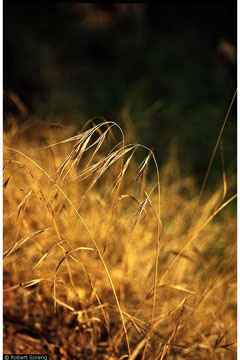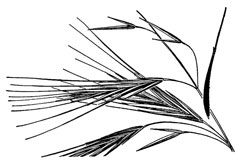 |
|
Robert Soreng @ USDA-NRCS PLANTS Database |
 |
| USDA-NRCS PLANTS Database / Hitchcock, A.S. (rev. A. Chase). 1950. Manual of the grasses of the United States. USDA Miscellaneous Publication No. 200. Washington, DC. |
Translate this page:
Summary
Ripgut brome seeds are edible and were historically used by Native Californians, but the plant is best regarded as a difficult and low-value food resource because of its dangerous awns and weedy nature. AKA: Bromus diandrus Roth ssp. rigidus (Roth) Lainz.
Physical Characteristics

 Bromus rigidus is a ANNUAL growing to 1 m (3ft 3in).
Bromus rigidus is a ANNUAL growing to 1 m (3ft 3in).
See above for USDA hardiness. It is hardy to UK zone 6. It is in flower from May to June. The species is hermaphrodite (has both male and female organs) and is pollinated by Wind, Cleistogomy (self-pollinating without flowers ever opening). The plant is self-fertile.
Suitable for: light (sandy), medium (loamy) and heavy (clay) soils, prefers well-drained soil and can grow in nutritionally poor soil. Suitable pH: mildly acid, neutral and basic (mildly alkaline) soils. It cannot grow in the shade. It prefers dry or moist soil and can tolerate drought. The plant can tolerates strong winds but not maritime exposure.
UK Hardiness Map
US Hardiness Map
Synonyms
Anisantha rigidus. (Roth.)Hyl. B. diandrus. Roth.
Plant Habitats
Cultivated Beds;
Edible Uses
Edible Parts: Seed
Edible Uses:
Seed[161, 177]. Used as a piñole, or dried and then ground into a powder and mixed with water to make a gruel[257]. The seed is small and would be rather fiddly to use[K]. Ripgut brome is a European species that spread widely across California and the arid Southwest, where it quickly became a common grass of disturbed soils and open rangelands. Despite its sharp, bristly awns that can injure livestock and pets, it was adopted as a traditional grain resource by Native groups, including the Karok, Luiseño, and Miwok Indians of California [2-3]. The seeds were gathered and prepared into mush, much like other wild grasses. Flowering occurs from April to June, with seeds maturing from June through August. While edible, the small grains require careful processing to separate them from the husks and awns, which are not only tough but can also irritate the mouth or digestive tract if not properly removed [2-3]. Caution: The long, barbed awns that give ripgut brome its name pose risks to animals and humans. Foragers must take care to process only the cleaned grains [2-3].
References More on Edible Uses
Medicinal Uses
Plants For A Future can not take any responsibility for any adverse effects from the use of plants. Always seek advice from a professional before using a plant medicinally.
None known
References More on Medicinal Uses
The Bookshop: Edible Plant Books
Our Latest books on Perennial Plants For Food Forests and Permaculture Gardens in paperback or digital formats.

Edible Tropical Plants
Food Forest Plants for Hotter Conditions: 250+ Plants For Tropical Food Forests & Permaculture Gardens.
More

Edible Temperate Plants
Plants for Your Food Forest: 500 Plants for Temperate Food Forests & Permaculture Gardens.
More

More Books
PFAF have eight books available in paperback and digital formats. Browse the shop for more information.
Shop Now
Other Uses
References More on Other Uses
Cultivation details
Succeeds in ordinary well-drained garden soil in a sunny position[138, 200]. The plant has cleistogamous flowers, these flowers do not open but produce seed by means of self-fertilization. USDA Hardiness Zone: 5–9 (adapted to Mediterranean and arid climates). Weed Potential: Ripgut brome is highly invasive in North America, especially in rangelands and disturbed soils. It competes aggressively with native plants and is considered a troublesome weed for ranchers due to its effects on grazing animals.
References Carbon Farming Information and Carbon Sequestration Information
Temperature Converter
Type a value in the Celsius field to convert the value to Fahrenheit:
Fahrenheit:
The PFAF Bookshop
Plants For A Future have a number of books available in paperback and digital form. Book titles include Edible Plants, Edible Perennials, Edible Trees,Edible Shrubs, Woodland Gardening, and Temperate Food Forest Plants. Our new book is Food Forest Plants For Hotter Conditions (Tropical and Sub-Tropical).
Shop Now
Plant Propagation
Seed - sow spring or autumn in situ and only just cover. Germination should take place within 2 weeks.
Other Names
If available other names are mentioned here
Ripgut Brome (Bromus diandrus Roth ssp. rigidus (Roth) Lainz)
Native Range
TEMPERATE ASIA: Israel, Syria, Turkey EUROPE: Hungary, Albania, Greece (incl. Crete), Croatia, Italy (incl. Sardinia, Sicily), Romania, Spain (incl. Baleares), France (incl. Corsica), Portugal AFRICA: Spain (Canarias), Portugal (Madeira Islands), Algeria (north), Libya (north), Morocco, Tunisia
Weed Potential
Right plant wrong place. We are currently updating this section.
Please note that a plant may be invasive in one area but may not in your area so it's worth checking.
Ripgut brome is highly invasive in North America, especially in rangelands and disturbed soils. It competes aggressively with native plants and is considered a troublesome weed for ranchers due to its effects on grazing animals.
Conservation Status
IUCN Red List of Threatened Plants Status :

Growth: S = slow M = medium F = fast. Soil: L = light (sandy) M = medium H = heavy (clay). pH: A = acid N = neutral B = basic (alkaline). Shade: F = full shade S = semi-shade N = no shade. Moisture: D = dry M = Moist We = wet Wa = water.
Now available:
Food Forest Plants for Mediterranean Conditions
350+ Perennial Plants For Mediterranean and Drier Food Forests and Permaculture Gardens.
[Paperback and eBook]
This is the third in Plants For A Future's series of plant guides for food forests tailored to
specific climate zones. Following volumes on temperate and tropical ecosystems, this book focuses
on species suited to Mediterranean conditions—regions with hot, dry summers and cool, wet winters,
often facing the added challenge of climate change.
Read More
Expert comment
Author
Roth.
Botanical References
17
Links / References
For a list of references used on this page please go here
Readers comment